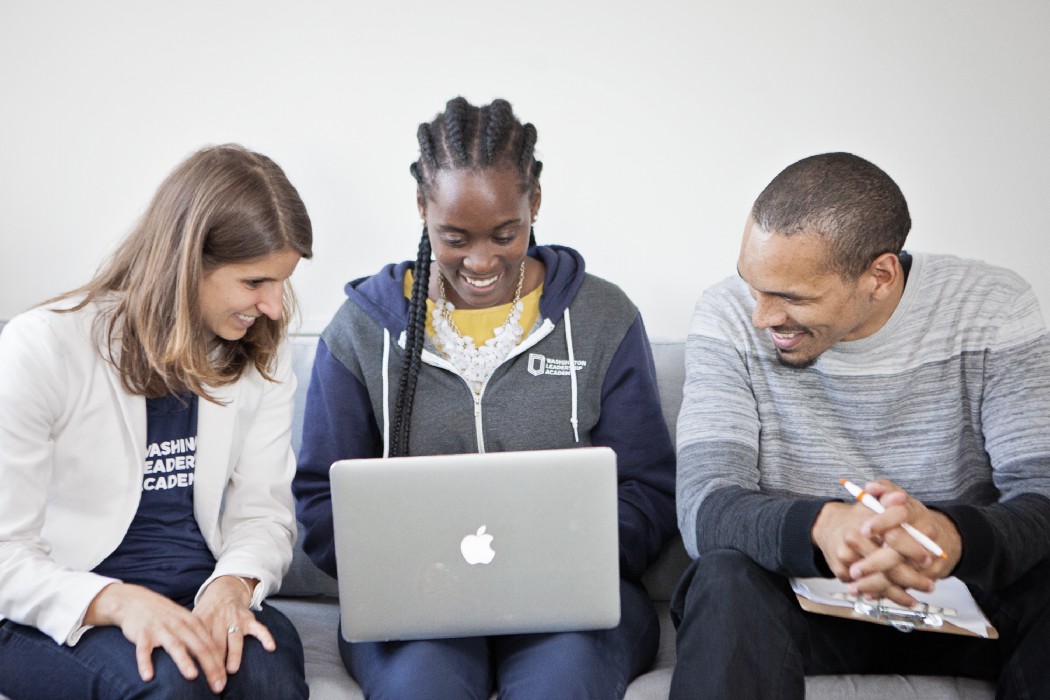Tips from XQ educators on creating the perfect internship program
By Wren Maletsky, Executive Director, and Adelaide Giornelli, Dean of Culture and Instruction at Summit Shasta; and Stacy Kane, Executive Director of Washington Leadership Academy
Internships can be a great way to give students real-world work career experience, a chance to learn valuable professional skills, and an opportunity to explore practical applications of their classroom learning. As part of our ongoing “How-To” series, check out these tips from two XQ Schools, Washington Leadership Academy and Summit Shasta, on how to prepare students for internships.
Tips from Summit Shasta’s Wren Maletsky and Adelaide Giornelli:
Build community relationships. Create a database of opportunities where campus-based coordinators can secure at least 60 possible placements for students in the community each year. After students find a passion (sometimes through their Expeditions experience), they often need support finding a best-fit location that will host an intern.
Involve campus-based coordinators. On-site coordinators can work with mentors to support the interests of students. The coordinator works alongside students through the sign-up process, the time-card process, and curriculum work that must be completed prior to starting the internship. A student is not disqualified for reasons such as gaps in time management skills; all students should have access to internships.
Create a capstone mentorship. This concept is still a work-in-progress but we envision an arc that connects a student’s initial curiosity with a placement during the student’s senior year. We offer at least eight University of California-approved electives, courses that could directly connect to majors and future fields of study. If a student finds a rigorous course experience that ignites a passion in their freshman or sophomore year, we hope to provide mentorship through their next two years of Expeditions decisions. This could include a student working as a teaching assistant for the course during their junior year, or opting into a self-guided study for AP test preparation. The Expeditions teacher offering guidance and support during the 11th-grade year would be the best resource for the student to connect with community organizations and find an internship placement in their senior year.
Want more information about the Shasta program? Check out Summit’s Independent Learning Program.
Tips from Washington Leadership Academy’s Stacy Kane:
Host recruiting events. The intern coordinator can reach out to businesses and community organizations to encourage buy-in. A host supervisor’s submitted online registration form indicates their agreement to host the number of interns they registered to supervise. Students may also bypass the interview process by recruiting their own host supervisor.
Set up students for success. To prepare for the internship experience, all 11th- grade students enroll in an internship preparation course. Students identify career interests and contact organizations related to those interests; develop, practice, and use effective communication skills; draft and finalize a resume; and practice and use interviewing and networking skills.
Excel in interviews. In order to secure an internship placement, students complete interviews on “interview Fridays,” which include an interview fair. Students can go to the organization for their interview or complete a phone interview.
Internship match. At the end of the interview period, organizations and students submit rankings of all interviews completed. Based on rankings, the coordinator makes final selections of interns for each organization. Students that are not matched are required to attend another interview fair in order to obtain a final placement.
Train and on-board. On-boarding allows students to practice their commute, meet their colleagues, and learn about the projects they will complete during their internship.
Coach and mentor. Host supervisors must design a project in conjunction with the student, convey expectations to the intern, record and report attendance with the advisor weekly, communicate any issues to the student’s advisor via email and meet with them monthly, and complete an evaluation at the mid-term and end of the internship.
Create an intern project plan. The host supervisor should provide the intern with meaningful tasks that allow them to gain insights into their career fields.
Learn more about student internships and real-world experience from these XQ blogs:
- How to Find an Internship in High School (Advice From a College Intern)
- From the classroom to the ‘real world’
- These students are learning from local businesses instead of textbooks
- This school set inside a museum is redefining education
Do you have tips about successful school strategies or teaching techniques? Send them our way! We’d love to share your “how to” expertise with other schools in the journey to rethink high school. Signup with your with your ideas and stories.
TAGS:







